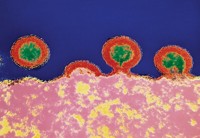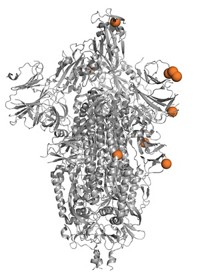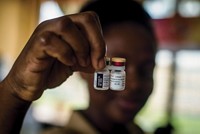Advertisement
Grab your lab coat. Let's get started
Welcome!
Welcome!
Create an account below to get 6 C&EN articles per month, receive newsletters and more - all free.
It seems this is your first time logging in online. Please enter the following information to continue.
As an ACS member you automatically get access to this site. All we need is few more details to create your reading experience.
Not you? Sign in with a different account.
Not you? Sign in with a different account.
ERROR 1
ERROR 1
ERROR 2
ERROR 2
ERROR 2
ERROR 2
ERROR 2
Password and Confirm password must match.
If you have an ACS member number, please enter it here so we can link this account to your membership. (optional)
ERROR 2
ACS values your privacy. By submitting your information, you are gaining access to C&EN and subscribing to our weekly newsletter. We use the information you provide to make your reading experience better, and we will never sell your data to third party members.
Biological Chemistry
Cautious optimism for an HIV vaccine
Largest clinical trial in seven years to test the efficacy of an HIV vaccine is kicking off in South Africa
by Ryan Cross
November 30, 2016
| A version of this story appeared in
Volume 94, Issue 48

HIV vaccine research is a field littered with letdowns. Disappointing results from hundreds of small clinical trials over the past three decades have led to only a handful of large Phase III clinical trials. And all of those failed, save for one: a controversial trial in Thailand that combined two vaccines, neither of which worked on its own. Many called it a waste of money, but the Thai trial shocked the HIV community in 2009 when it became the first to boast a vaccine that provided protection against HIV infection.
Seven years later, a highly anticipated sequel to the Thai trial is making its debut across South Africa. Although the vaccine used in the Thai trial was technically a success, its 31.2% reduction in HIV infection compared with placebo was too modest for commercial vaccine approval. The new trial, which last month began testing a vaccine that’s only marginally modified from the one used in the prior Thai trial, will enroll 5,400 South Africans, aiming to achieve at least 50% reduction in HIV infection. If the vaccine can provide that level of protection for three years, it could become the first licensed preventative HIV vaccine.
Researchers have struggled for three decades to develop a successful HIV vaccine. “It has been a uniquely hard scientific challenge,” says Lawrence Corey, founder and leader of the Human Vaccine Trials Network (HVTN), which is orchestrating the new South African trial, called HVTN 702.

Note: gp120 proteins are proteins on the outer coating, or envelope, of the HIV virus. a Not adjusted for inflation and calculated over the course of entire trial. b Estimated.
In 1984, scientists discovered the virus—later named HIV—responsible for acquired immunodeficiency syndrome (AIDS). At the time, groups of AIDS patients with compromised immune systems, some afflicted with conditions such as cancerous skin lesions and a rare type of pneumonia, were begging doctors for help. Soon after the virus was identified, U.S. Health & Human Services Secretary Margaret Heckler said, “Yet another terrible disease is about to yield to patience, persistence, and outright genius.” She predicted that a vaccine would be ready for testing in about two years.
Of course, Heckler was wrong. The Joint United Nations Program on HIV and AIDS (UNAIDS) estimates that about 36.7 million people were living with HIV at the end of 2015 and that 1.1 million died from illnesses caused by AIDS. That’s a huge improvement compared with the outbreak’s mortality peak in 2005, when AIDS killed about 2 million people per year. But it’s a far cry from success.
“Thirty-five years into the epidemic, the disease is neither preventable nor contained,” says Arne Naeveke, a spokesperson for the International AIDS Vaccine Initiative. South Africa is particularly hard hit, with about 19% of the population ages 15 to 49 living with HIV. “And with a population increase in South Africa expected, there is a risk that all the benefits we have seen in bringing down AIDS could bounce back,” Naeveke adds.
Although antiretroviral drugs and nonvaccine prevention strategies have worked wonders to reduce the scale of the AIDS epidemic, the global rate of new HIV infections hasn’t dropped over the past five years. Many researchers and clinicians agree that a vaccine is sorely needed to end the virus’s spread. They just have strong and varied opinions on how best to do it. Some think HVTN 702 could move the needle in vaccine research. Others have qualms with the trial, favoring investment in other large HIV vaccine efforts that are simultaneously under way. Because of this confluence of HIV vaccine research activity worldwide, Corey says he has “cautious optimism about our ability to make an effective HIV vaccine.”
HIV is a wily retrovirus that integrates its own genome into human DNA and turns a person’s cells into little virus factories. To make matters worse, HIV preferentially targets cells in the immune system—normally, the body’s defenders. Robert Gallo, who was one of the first to discover that HIV causes AIDS and is now at the University of Maryland, says that just like diamonds, “retroviruses are forever.” HIV’s enduring integration into human cells coupled with its breakneck mutation rate makes it a devilishly difficult target for the human immune system to combat and for vaccine researchers to tackle.
For many viruses—including those that cause measles, smallpox, and polio—scientists have proof that the human body can clear the virus on its own and develop a lifelong immune response, providing protection from future infection with the same virus. Simply presenting the immune system with a portion of one of these viruses, or a whole virus that has been inactivated, is enough to generate antibodies that will protect a person for life. “That’s very important because nature has provided you with a proof of concept, that you know the body can do this,” says Anthony Fauci, director of the National Institute of Allergy & Infectious Diseases (NIAID).
HIV researchers don’t have that luxury. Infected individuals develop antibodies that target the virus, but HIV’s nonstop mutation and ever-so-slightly shifting structure typically make such antibodies worthless.
A small fraction of people infected with HIV, however, do develop antibodies that keep apace with HIV, mutating repeatedly to match the virus. These so-called broadly neutralizing antibodies bind and nullify a wide array of HIV strains. But it can take the immune system years to develop those antibodies, and it is usually too little, too late to be of much help. That’s why scientists are racing to develop a preventative vaccine that stimulates the body to produce broadly neutralizing antibodies early on. But nothing is close to working in humans yet.
The Thailand trial that HVTN 702 is modeled on did not elicit the highly desired broadly neutralizing antibodies. Instead, participants who received the vaccine developed what are called binding antibodies to a specific region on the outer protein coating enveloping HIV. Unlike neutralizing antibodies, binding antibodies don’t prevent a virus from infecting a cell directly; they just mark a target for destruction by other players in the immune system.
“I’ve personally spent a lot of time championing the broadly neutralizing antibody approach,” says Wayne C. Koff, president of the Human Vaccines Project. “But I think one has to be really humble here in terms of pronouncing what is important. At the end of the day, efficacy trumps anything,” he adds, suggesting that if HVTN 702 works well, the vaccine strategy doesn’t matter.
The HVTN 702 trial is currently enrolling men and women across 15 sites in South Africa, where half the trial’s 5,400 sexually active, HIV-free participants will receive five vaccinations over the course of a year. The other half will receive placebo shots in a double-blinded experiment where neither group will know which set of injections they are receiving. All the men and women will also receive counseling on practices to prevent infection and will be tested for HIV every three to six months after vaccination, for at least three years.

Glenda Gray, the principal investigator for HVTN 702 and president of the South African Medical Research Council, says the trial is stirring up interest and national pride. “There is so much excitement; it kind of scares me because there is so much at stake,” Gray says. She estimates the endeavor will cost $130 million, roughly split between NIAID and the Bill & Melinda Gates Foundation. That doesn’t include the cost of the combination vaccine, the components of which are produced by Sanofi Pasteur and GlaxoSmithKline. Sanofi is paying for the vaccine itself and GSK is paying for it with previous grant money.
For nonplacebo participants, all five site visits will include a shot of Sanofi’s ALVAC-HIV vaccine, a harmless canarypox virus engineered to harbor DNA coding for certain HIV genes. The canarypox virus serves as a shuttle that carries the synthetic HIV genes into human cells. Once there, this DNA can be translated by the cells to make proteins similar to those found in HIV. The goal is to prime a person’s immune system to HIV without actually risking infection.
Researchers in charge of HVTN 702 will administer an additional vaccine, the so-called “booster” portion of the regimen, to nonplacebo trial participants on the last three visits. This vaccine, produced by GSK, includes two variants of gp120, a protein found on HIV’s outer coating, or envelope. It also contains an adjuvant, or immune-stimulating substance. For this trial, the adjuvant, called MF59, is an oil-in-water emulsion containing the molecule squalene that’s already been approved for use in flu vaccines. Exactly how the emulsion delivers its immune booster remains unclear.
Scientists intentionally designed this HVTN 702 regimen to be similar to the one used in the so-called RV144 trial held in Thailand, which also administered an ALVAC-HIV shot combined with a booster (N. Engl. J. Med. 2009, DOI: 10.1056/nejmoa0908492). That trial began in 2003 and enrolled more than 16,000 volunteers. RV144 participants received only four vaccinations, instead of five, and used a standard aluminum hydroxide gel as an adjuvant instead of MF59.
The DNA loaded into the canarypox virus of the RV144 vaccine was designed to match the strain of HIV circulating in Thailand. The gp120 proteins delivered in the booster shot also mirrored what was found in the local HIV. “RV144 was truly a boutique vaccine,” says Chris Beyrer, a professor at Johns Hopkins Bloomberg School of Public Health and the immediate past-president of the International AIDS Society. “And that probably turned out to be important, as it was the first vaccine to show some efficacy,” he adds. HVTN 702 builds on that principle by tailoring a portion of the ALVAC vaccine and the gp120 proteins to match the predominant strain of HIV found in South Africa.
Some researchers are questioning the merits of the South Africa trial, arguing that other efforts such as a broadly neutralizing antibody vaccine should take priority. But most researchers simply wonder whether the minor improvements seen in the Thai trial can be replicated in South Africa.
The efficacy of the RV144 vaccine was a modest 31% after 3.5 years, but “the confidence intervals came perilously close to zero,” Beyrer says. In other words, the results were on the verge of statistical insignificance. Beyrer says that if the trial participants were followed for another year, the trial would have almost certainly showed no efficacy.
NIAID’s Fauci says RV144 was “not ready for prime time, but at least it is an inkling of a signal.” The efficacy of RV144 was closer to 60% after the first year, but antibody levels waned after that, resulting in less protection against HIV. That’s why HVTN 702 is adding a fifth vaccination and a potentially stronger adjuvant to try to prolong the immunity seen early in RV144.
Bumpy road for HIV vaccine trials
1984: Scientists discover HIV, the retrovirus responsible for AIDS. Officials are optimistic a vaccine will be ready for testing in two years.
1998: The first Phase III HIV vaccine efficacy trial begins. It tests AIDSVAX, a mix of gp120 proteins and aluminum hydroxide gel adjuvant. AIDSVAX is later declared ineffective.
2003: The Phase III RV144 Thailand trial begins, testing a combination of AIDSVAX and canarypox-virus-based ALVAC-HIV vaccines, each of which failed alone.
2004: Twenty-two HIV vaccine researchers publish a letter in Science (DOI: 10.1126/science.1094620) questioning the rationale of the RV144 trial.
2007: Two large Phase IIb trials in the U.S. (HVTN 502) and South Africa (HVTN 503) testing an adenovirus-based HIV vaccine from Merck are halted when the vaccine shows no efficacy. Subsequent analysis shows the vaccine slightly increased risk of HIV infection in participants.
2009: The RV144 trial in Thailand becomes the first HIV vaccine to show some efficacy over placebo, albeit a modest 31.2%.
2013: A Phase IIb trial (HVTN 505) testing the safety and efficacy of an adenovirus-based DNA vaccine from the Vaccine Research Center is cut short because it shows no efficacy.
2016: Two Phase IIb AMP trials (HVTN 703/HPTN 081 and HVTN 704/HPTN 085) begin testing the injection of a broadly neutralizing antibody called VRC01 in patients.
November 2016: Phase III HVTN 702 trial begins in South Africa, testing a combination of the ALVAC-HIV vaccine and a GlaxoSmithKline booster containing a squalene-based adjuvant.
Late 2020: Results expected for HVTN 702 efficacy trial.
The University of Maryland’s Gallo has emphasized that the single most important avenue of HIV vaccine research should be understanding why antibodies from the vaccine don’t last. “If we don’t solve that problem, nobody is going to make any successful vaccine for any retrovirus,” Gallo says.
Although HVTN 702 is adding the MF59 adjuvant to help with this problem, Gallo says sometimes in monkeys the adjuvant activates too many T cells and causes the vaccine to lose its efficacy. Because T cells are a part of the immune system that helps seek and destroy virus-infected cells, it may seem counterintuitive that having too many of them is a problem. But HIV has become particularly good at infecting T cells. Boosting T-cell levels too much just gives HIV more real estate. “There is a sweet spot,” Gallo says. “I don’t want to criticize the trial; I want it to go on.” But, he adds, his lab has observed that simply using a different adjuvant won’t keep antibody levels high.
Unfortunately, only a trial in humans will show whether the vaccine works. “Mice lie and monkeys exaggerate,” says James Mullins of the University of Washington, referring to traditional animal tests in preclinical trials. Mullins conducted analysis on data from the RV144 trial to find out what was different in the immune systems of those who received the vaccine and those who didn’t.
Advertisement
Mullins found that two variations in the part of the gp120 protein called variable loop 2 resulted in either a higher or lower likelihood of infection, meaning that the vaccine protects against one version of HIV better than the other (Nature 2012, DOI: 10.1038/nature11519). Mullins says this persuasively shows that RV144 efficacy “was not a statistical fluke,” a criticism made by researchers who opposed the RV144 trial and consequently think that HVTN 702 is a waste of funds. Such researchers often say efforts would be better directed toward understanding how to make a vaccine that induces broadly neutralizing antibodies.

Others aren’t as concerned with how the vaccine works, so long as it works. “If you get protection, I don’t really care what the mechanism is to be honest with you,” Fauci says. “I think we have to be careful about fixating on a predetermined assumed correlate of protection when there may be multiple ways to protect against HIV.”
Fauci also points out that broadly neutralizing antibody research is not being left behind. Two large clinical trials run jointly by the Human Vaccine Trials Network and the HIV Prevention Trials Network will be the first big test for broadly neutralizing antibodies. Forty-two hundred volunteers across the U.S., South America, and Africa will enroll in the Antibody Mediated Prevention (AMP) study, providing a series of 10 intravenous injections of a broadly neutralizing antibody called VRC01, which was isolated and is manufactured by the Vaccine Research Center at the National Institutes of Health. The ongoing study began enrolling volunteers in the spring.
The goal of the AMP trials is to determine what level of neutralization, or the amount of antibodies, is needed for protection. “Obviously, we hope that neutralization does cause protection, and if it doesn’t, then gee, we have a lot to learn about HIV, Corey says. “So it really is a milestone trial.”
“There are more promising ideas making it into large clinical trials than ever before,” says Mitchell Warren, the executive director of the AIDS Vaccine Advocacy Coalition. Although the results of the HVTN 702 efficacy trial will not likely be known until late 2020, the pace of concurrent HIV vaccine efforts is gaining speed. “We really are seeing one of the most optimistic moments,” Warren says.
“I think there are still a lot of naysayers about HVTN 702, and I just shrug my shoulders,” Corey says. “The enemy is HIV, not your colleagues.”





Join the conversation
Contact the reporter
Submit a Letter to the Editor for publication
Engage with us on Twitter